|


The
Identification and Attribution
of
CHRISTIAAN
HUYGENS'
First Pendulum
Clock.
(a
(Type
Ctrl+F
to find any word on this page)

INTRODUCTION
It is an awkward irony, to be obliged to begin by advancing a
proposition which contradicts some of the studies on which it itself is
based. Here, in identifying and attributing Christiaan Huygens’ first
pendulum clock, it is necessary to dismiss the notion that his first
clockmaker was Salomon Coster (1620-1659) or that he developed his
invention without using a clockmaker at all. Both assumptions, though
flawed, are revealing and examination of them provides the best
introduction.

NOT ALONE
Huygens mentions no clockmaker in connection with the development of his
innovation. However, it is most unlikely that he would have launched his
paradigm change in a centuries-old craft without experimenting on the
purpose- made product of a practitioner. To have done so would be
contrary to the quantitative method of this great empiricist. He
required precise values. In this case he needed to know the scope and
limits of his invention before divulging it. Huygens dates his invention
to December 25 1656.(1
This date
should not be regarded as marking an Archimedean inspiration on the
basic principle of pendulum control. In fact, although it has often been
said that he applied the pendulum to clockwork, it is perhaps truer to
say that he brought clockwork to the pendulum. His original intention
was, in part, to relieve astronomers from the task of impelling and
counting the oscillations of the manual pendulum then in use for timing
observations(2
Having realised how this could transform clockwork he
would surely have commissioned a specially transformed clock. Christmas
day 1656 therefore, probably signifies the completion of the last
missing element of a tried and tested machine. Nothing less than the
high performance of such a machine would have allowed Huygens to reveal
immediately to others, his hopes of solving the longitude problem(3. By
the beginning of 1657 he must have achieved a roughly two orders of
magnitude increase in accuracy over pre-pendulum timepieces, obtaining
results to within a few seconds per day. How else could a mathematician
flatter himself that his invention was immanently relevant to maritime
longitude? Apart from longitude he urgently required the best possible
timepiece for his astronomical observations, for his studies of
accelerated motion and his search for the constant of gravitational
acceleration where his conical pendulum later provided the key. Logic
alone therefore suggests that when Huygens realised the potential of a
pendulum escapement, he commissioned the finest machines possible with
which to experiment further.
●
There is evidence that confirms what logic supposes. Firstly there are
the material results of this experimentation in the refinements he
developed before obtaining a patent: maintaining power, optimal gear
train, pendulum crutch with flexible suspension and isochronal cheeks(4.
These considerable intricacies required professionally made machinery
and lengthy experimentation. Many months would be needed to evaluate the
Flemish astronomer GodefroyWendelin’s (1589- 1667) proposition of
seasonal variations alone(5. Secondly there is written evidence.
On the
1” November 1658, he distantly recalls in a
letter to Pierre Petit, (1598-1677):
|
...at
first I suspended the pendulum between two curved plates
...
,which by experiment I learned ... how to bend...
And I remember having so well adjusted two clocks in this manner
that in three days they never showed a difference of even
seconds although in the meantime I often changed their weights
rendering them heavier or lighter
(6.
|
It is tempting to speculate that it was the empirical perfection of
these isochronal cheeks that was commemorated on the
25 December 1656. To one of the finest geometers of his age, the resolution of what must
have been for him the ugly inconsonance of the tautochrone and the
circle would have been particularly pleasing. However, it is clear from
this passage that he shaped his isochronal cheeks by experimenting with
(at least) two weight-driven, seconds indicating clocks. Since the
profile of these cheeks was part of Huygens’ invention, these
experiments must have taken place in
1656. In April 1657, two months before the patent
application, Claude Mylon (1618-1660) expresses in a letter, the wish
that Huygens’ clock will go as well with a spring as it does with
weights, ‘one could wish for nothing more for the longitude.(7

NOT WITH COSTER
So who made these clocks? And indeed who made the clock drawn in
Huygens’ patent application of 14 June 1657, which was approved 2 days
later, after the actual timepiece was inspected by a committee of the
States
General of the United
Netherlands?
It has been assumed that the answer to both questions is Huygens’
assignee Salomon Coster. Before considering why Huygens would have
forsaken his original clockmaker, the evidence against Coster’s
involvement at the experimental stage will be set out.
●
Firstly, a passage that has been cited as pointing to Coster’s priority
is ambiguous and problematic. In Horologium Huygens wrote:(8
...diligent
artificers whom I have informed of the principle of this
invention have been able to add much to it, and they will
discover without difficulty how to apply it to various kinds of
clocks also to those made long ago in the old style. I have
indeed seen in the workshop of him whose labours I first
employed for these constructions, completed clocks which go, not
by weight, but by force of a spring. In this kind of work up to
the present time, the differing power of the spring when wound
up and when wound down was equalised by a fusee, round which was
coiled a gut line; now these are disused. For the teeth are
brought together with the barrel itself in which the spring is
enclosed ....
I pass over clocks of this kind which have been contrived to
sound the hours by one and the same motor, either a weight or a
spring, which serve also for turning the hand of the timepiece,
since all these have nothing to do with my invention except as
occasioned by the opportunity it presents. |
Who, apart from Coster, were these artificers who had been able to do
much to Huygens’ invention? Why use the phrase ‘him whose labours I
first employed’ if, as has always been assumed, Huygens had only one
licensee at the time of writing? Fond as Huygens may have been of the
personal metonym, he could have referred to Coster as he did in his
letter to Pierre Petit of November
1” 1658, as ‘my worker’ or, for example, my
licensee ?
Also, the words, ‘I have indeed seen in the workshop(9
are an unlikely description of Coster’s clocks which he describes in the
opening chapter as, ‘having had many copies ... already for sale and for
sending forth in all directions’. Is it the clocks, made long ago in the
old style, which Huygens had indeed seen, (now converted to pendulum) in
the clockmaker’s workshop? This interpretation better accommodates the
words ‘indeed’ (or ‘truly’, ‘quidem’) and ‘completed clocks’ (‘talia
quoque confecta’). One can imagine the memorable sight of, say, a
horizontal table clock put on its side and converted to pendulum. The
last part of the above passage beginning, ‘now these are disused’ (i.e.
fusee and chains) and describing going and tandem barrel clocks, may
quite properly be interpreted as referring to Coster’s spring clocks.
However, they may not be the clocks ‘seen in the workshop of him’ whom
Huygens first employed. Lastly, the identity of that first employee
depends on a precise identification of ‘these constructions’ which may
refer only to the commercially available clocks and not his experimental
clocks.
●
The circumstances of the patent application may be very significant.
Huygens allowed Coster to present the patent request on his behalf. This
would appear uncharacteristically trusting of Huygens and suggests that
the scientist felt in complete control. It is known that the design was
Huygens’ own and that the Committee of the States General went to
inspect the actual clock before consenting two days later.(10
They subsequently refer to the invention as ‘done by Huygens’
(‘gepractiseert’ by’(11)
with permission for Coster to copy (‘naer te maeken’). This re enforces
the impression that Coster introduced the committee to a clock not made
by him.
●
In summary, no surviving written reference points to Coster as having
been anything other than the sudden and fortunate recipient of Huygens’
commercial assignment.
●
The tangible evidence supports this view. None of the seven surviving
examples of Coster’s work exhibit the slightest rigour of Huyghenian
science. The simple going barrels, hinge swinging movements, inferior
box pillars and cycloidal cheeks are led by the lack of a seconds dial,
in denying any pride in this horological revolution. Admittedly Huygens
considered their design fit for domestic purpose and they justify the
very high antiquarian affection that they currently enjoy. Much
significance has been attached to their dated plaques. It is unusual for
clocks of any period to be dated. However, it is possible that these
plaques were originally tokens, purchased by Coster from Huygens and
representing paid dues on the licence for each clock sold. The plaque
would have been provided with ‘met privilege’ and perhaps the date,
etched in facsimile on them, but otherwise blank for Coster or his
nominee to engrave as they wished.(12
Coster partisans may blame misfortune
for leaving us only examples of his pendulum clocks intended for modest
domestic use. However, there is no indication in Coster’s price list of
work more worthy of the original maker and the appetite of time’s
consumption is not usually so selective.

REASONS FOR CHANGING CLOCKMAKERS
Why would Huygens overlook his original clockmaker when licensing his
patent? There are at least three plausible reasons for so doing.
Firstly, he himself tells us at the beginning of Horologium that he
wished to give his native country,
Holland,
the benefit of his invention. Were that country not the domicile or
nationality of his clockmaker, then eventual disfranchisement would have
been inevitable.
The very fact that Huygens mentions this wish could indicate that there
was an unusual option in a matter, like patriotism itself, normally
taken for granted. Secondly, Huygens’ most treasured possession was his
intellectual property. He may well have thought this would be better
protected by separating development from commercial production. Thirdly,
being in the vanguard of research in the physical sciences, it was
clearly to his advantage to have a more accurate timepiece than anyone
else. He may well have deliberately confined readily available
production to the inferior models of a separate clockmaker. The question
then arises as to whether or not there was an aggrieved clockmaker and
if so, why there are no recorded repercussions. The obvious explanation
is that this clockmaker had little or no creational input, and accepted
from the onset strict conditions of secrecy and the absence of potential
patent rights. Perhaps a notary was involved. However it should also
here be remembered that there is at least one reference to a counter
claim by a clockmaker. Jean Chapelain (1595-1674)
 mentions in a letter to Huygens of
20 August 1659, a clockmaker of
Paris,
(‘de notre’), ‘who has tried to rob you of your claim’. The editors of
the Oeuvres Completes conclude that this is probably a reference to
Isaac Thuret (c.1 However they produce no evidence to support this
supposition.(13
mentions in a letter to Huygens of
20 August 1659, a clockmaker of
Paris,
(‘de notre’), ‘who has tried to rob you of your claim’. The editors of
the Oeuvres Completes conclude that this is probably a reference to
Isaac Thuret (c.1 However they produce no evidence to support this
supposition.(13
●
The document that could well settle the mystery of Huygens’ first
clockmaker is the design submitted through Coster to the Committee of
The States General. Sadly, as Drummond Robison(14
lamented 77 years ago,
this has been lost and there are no known copies; or are there?

THE NEGLECTED EVIDENCE
It has long been assumed that the earliest surviving illustration of a
clock by Huygens is that contained in his Horologium of 1658. This
illustration shows his second type of clock, with vertical verge
escapement, ‘O-P’ gearing to narrow the pendulum amplitude, and lack of
isochronal cheeks. This clock beats half-seconds (Fig. 1). The other
published illustration of a conventional pendulum clock by Huygens is
the more famous illustration in Horologium Oscillatorium published 15
years later in 1673.

Fig. 1 (click to enlarge)
Christiaan Huygens’ earliest published
illustration
of a clock, showing his second type of clock
with 0-P
gearing, Horologium, (1658).
(view
high res. picture)
This shows a seconds beating clock with isochronal cheeks and horizontal
escapement Fig. 2. It has been assumed that this is an illustration of a
regulator made for Huygens sometime in the middle or late 1660s.
In fact, this is an illustration of Huygens’ first pendulum clock of
1656/7. In all probability it is copied from the original design that
accompanied his patent application. The proof for this is fortunately
preserved in Benjamin Martin’s (1705-1782) book of 1764, Newtonian
Mathesis(15
original woodcut of 1657 and illustrated it Mathesis) Martin somehow
obtained Huygens’ (Fig. 3) along with the following description:
|
The construction for application of the Pendulum is now somewhat
different from what it was in the original Invention of the
Pendulum Clock by Mr. Christian HUYGENIUS of Zulichem in
Holland
which he first described and published in a diagram cut in Wood
in the Year 1657. And as this may be Justly esteemed as one of
the great Curiosities of Art and was never (that we know of)
exhibited to the view of an English Reader, we shall here
present it, cur in Wood exactly as the Original.
|
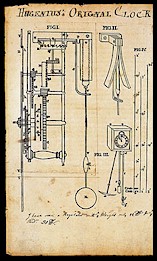
Fig. 2 (click to enlarge)
Horologium Oscillatorium, (1673).
The plate from Benjamin Martin's copy.
(view
high res. picture)
This woodcut is the same side view of the movement illustrated in
Horologium Oscillatorium, though of a different size and without the
pendulum weight or fine adjustment weight. Martin was so taken by this
discovery that he annotated his own copy of Horologium Oscillatorium
with the words, ‘Huygenius’s
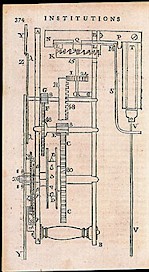
Fig. 3 (click to enlarge)
Newtonian Mathesis (1754).
A copy of Huygen's woodcut of 1657
(view
high res. picture)
Original Clock’ above the illustration (Fig. 4).(16
He also reckoned the
date described by Huygens noting, ‘1657 first published his clock’ no
doubt delighted that Huygens’ opening words, ‘Ann us agitur sextus
decimus ex quo fabri cam horologiorum’ tallied with the date of his
woodcut (Fig. 5).

Fig. 4 (click to enlarge)
Benjamin Martin’s annotation above the plate of his copy of Horo/ogium
Oscillalorium.

Fig. 5 (click to enlarge)
Benjamin
Martin’s reckoning of the date on the title page of his copy of
Horologium Oscilatorium.
Since Martin states that the woodcut has never to his knowledge been
seen by an English reader, one wonders whether it was part of the
auction in
Holland
in 1754 of Huygens’ effects. This auction included lenses, a planetarium
and a clock which were purchased by Huygens’ great nephew A.J. Royer,
and left in 1809 to
Leiden
University.(17
●
The fact that Huygens chose to illustrate his first clock in a work
published 16 years later should not come as a surprise to Huyghenian
scholars. It has been known for some time that all but the last part of
Horologium Oscillatorium was drafted by the end of
1659.(18 In
all probability the first chapter was started in October 1659 (although
information on sea trials was appended later). It is obvious that
Huygens would not have commenced his description of the clock without an
annotated diagram. By 1659, with his discovery and proof of the
cycloidal tautochrone, he had discarded his second type of clock with
‘O-P’ gearing (illustrated in Horologium).
There would have been every reason to illustrate his original clock,
probably supplying the diagram of his patent application. The o
improvement on the original clock was an invisible one; the cheeks were
now cycloidal. This was left to the text to explain. There is further
evidence to show that Horologium Oscillatorium used an early diagram
which was later modified.
The theory and shape of the fine adjustment weight which was developed
in the early 1660's
is given a non sequential Greek letter ‘Δ'
indicating that it was not part of the original diagram. The linear
scales from which the theory of this weight was derived, on the far
right (fig. liv in the plate) appear also to be a later addition.(19 Their
description is contained in part 4, written in 1664. It is interesting
to note that Martin’s woodcut does not include this fine adjustment
weight.

Fig. 6 (click to enlarge)
A French engraving of 1671 showing Huygens’ clock which appeared 2 years
later in Horologium Oscillatorium.
There is other evidence that a drawing of Huygens’ first clock
had some circulation before Horologium Oscillatorium. It is included in
a French engraving of 1671 (Fig. 6).(20
A
similar
clock with a great wheel of 96 teeth, is illustrated in a letter Huygens
wrote to Canon Estienne (?- 1723), in 1669.(21
Martin’s description
therefore, must be considered conclusive and the identity of Huygens’
first clock established beyond doubt. Since the thesis of this article
was largely written before discovery of this description, it is not with
the benefit of hindsight to note that the Horologium Oscillatorium
clock shows all the signs of being the prototype.
There are elements which do not flourish in subsequent production; the
boat-shaped pendulum bob, the large diameter escape wheel pinion, the
seconds disc. Being a weight-driven clock beating seconds, it has the
specifications that one would imagine Huygens required to test pendulum
theory. The introduction to the clock and its detailed description in
the text of Horologium Oscillatorium, make more sense as a celebration
of the original movement than the random inclusion of a subsequent
model. Had Huigens wished to be up to date with developments in 1673, he
would presumably have illustrated the anchor escapement.
End
of this section, click
here to continue.

 |
Notes: |
|
A |
 |
Reprinted from the December 2008 issue
of Antiquarian Horology’.
(back
to text)
|
|
|
1. |
 |
M. Nijhoff, Oeuvres Completes de Christiaan Huygens (The Hague,
1932), vol.2, p.l Huygens gives this date for the ‘first model
of that type of clock’ in a letter he sent to Ismail Boulliau
(1605-1694).
(back
to text) |
|
Ismail Boulliau |
|
|
|
2. |
Christiaan Huygens, Horologium (The Hague, 1658), P.4. (back
to text) |
|
3. |
Nijhoff, Op. Cit. vol.2 p. Letter from C.H. to van Schooten, 121
Jan 1657, see also p.7, for letter from Huygens to Mylon, 1”
February 1657. Both letters express the hope that the invention
will be applied to the determination of longitude.
(back
to text) |
|
4. |
The term ‘isochronal’ is here used to describe the purpose and
not the strict qualification. Huygens shaped his cheeks
empirically at this time.
(back
to text) |
|
5. |
Huygens, op. cit. p.1 ‘to me certainly it was not given to
observe anything of this kind ...‘ is Huygens’ comment on
Wendelin’s proposition of variations, (presumably caused, in
part by temperature change) and indicating that he had tested
his invention through the seasons.
(back
to text) |
|
6. |
Nijhoff, op. cit. vol.2, p. (back
to text) |
|
7. |
Nijhoff, O cit. vol.2, p. (back
to text) |
|
8. |
Huygens, O Cit. p.1 (back
to text) |
|
9. |
The word ‘workshop’ is a translation by Ernest L. Edwards, of
the Latin ‘apud’ which is a preposition governing the accusative
case and has a wide range of meaning including ‘at the house
of’, ‘in the works of’, ‘among’, ‘before’, ‘in the presence of’,
etc. It is not certain therefore that Huygens specifically saw
these clocks in a ‘workshop’ for which he could have used the
word ‘officina’. This may become significant with regard to the
location of these clocks seen by Huygens.
(back
to text) |
|
10. |
Nijhoff, op. cit. vol.2, pp. (back
to text) |
|
11. |
The precise definition of the Dutch verb ‘practiseeren’ would
here seem to lie somewhere between ‘carry out’ and ‘use’. It
gives the impression that what the committee saw was ‘done’ by
Huygens and not Coster. A contemporary account of the murder of
William the Silent describes the deed as ‘gepractiseert’ by the
murderer! (back
to text) |
|
12. |
Some plaques have ‘met privilege’ and the date etched or
scratched on them in script different from the Coster signature;
these plaques would appear to be original.
Viz:
Huygens’
Legacy, Hans van den Ende, et. at (Fromanteel Ltd: Isle of Man,
2004), p. (back
to text) |
|
13. |
Nijhoff, Op. Cit. vol.2 p. |
|
14. |
J. Drummond Robertson, ike Evolution of Clockwork (London,
1931), p. (back
to text) |
|
15. |
Benjamin Martin, A New Comprehensive System of Mathematical
Institutions Agreeable to the Present State of Newtonian
Mathesis (London, 1754). Vol. 2. pp.373 For Martin see, JR.
Milburn, Retailer of the Sciences (London, 1986).
(back
to text) |
|
16. |
Christiaan Huygens, Horo/ogium Oscillatorium ... (Paris, 1673).
Sold Christie’s, London, December 2006, Lot 81. Provenance;
Benjamin Martin (double signature on title page, pen drawings,
occasional notes and calculations), John Pope, 1784, (book
plate), John Jackson (pencil signature). (back
to text) |
|
17. |
C.A. Crommelin, Descriptive Catalogue of the Huygens Collection
.. (Leiden, 1949), PP. |
|
18. |
Joella
C. Yoder, Unrolling Time (Cambridge, 1988), p.5. (back
to text) |
|
19. |
It is clear that a smaller script has been used in fig. IV of
Plate One of Horologium Oscillatorium. (back
to text) |
|
20. |
A.E. Bell, Christiaan Huygens and the Development of Science in
the 17th.
Century
(London, 1947), Plate 3. (back
to text) |
|
21. |
Nijhoff op. cit. vol.6 pp. (back
to text) |
|
22. |
Johan Lulofs, Waarneeming van Mercurius op de schyf der
Zon, den 6Mey 1753, gedaan Ce Leyden (Haarlem, 1754), pp.37
(back
to text) |
|
23. |
R.H. van Gent & J.H. Leopold, Timekeepers of Leiden
Observatory
(Leiden, 1992), p. note 37. (back
to text) |
|
24. |
Reinier Plomp, ‘A pendulum Clock Owned by The Danish Astronomer
Ole Rømer (1644-1710)’ Antiquarian Horology 30/5 (March 2008),
624-628. (back
to text) |
|
25. |
They have been checked with their TPI and, as to be expected, do
not conform to any standard threads. They have nor yet been
compared to the threads or diameters of the Boerhaave clock.
(back
to text) |
|
26. |
J-D. Augarde, Les Ouvriers do Temps (Geneva,
1996), p.
(back
to text) |
| 27. |
Nijhoff, op. cit. vol. 1V, p.llO.
(back
to text) |
|
28. |
Nijhoff, op. cit. vol.V, p.383.
Also RH. van Gent & J.H. Leopold, op. cit. p.l3. (back
to text) |
|
29. |
Reinier Plomp, ‘A longitude timekeeper by Isaac Thuret .with the
Balance Spring Invented by Christiaan Huygens’ Annals of
Science’ 56 (1999), (back
to text) |
|
30. |
Yoder, op. cit. p
(back
to text) |

back
|
 |
By:
Sebastian Whitestone
&
Jean Claude Sabrier. |
Reprinted from the December 2008 issue
of Antiquarian Horology’. |
 Back to end of previous section.
Back to end of previous section.

TWO SURVIVING EXAMPLES
Martin’s copy of Huygens’s woodcut, (and of course the plate in
Horologium Oscillatorium), show a movement known only in the work of
Isaac Thuret. There are at least two examples of this exact movement.
One is a hitherto unpublished example discovered 30 years ago by
Jean-Claude Sabrier. The other example is now in the
Boerhaave
Museum,
Leiden
(Figs 7 & 8) and is held by long tradition to have been the personal
property of Christiaan Huygens. In 1754 Johan Lulofs (1711-1768) wrote
of his observations at Leiden, ‘the timepiece that I used was made in
Paris by Thuret under the supervision of Mr. Huigens... ‘.(22
Leopold and van Gent(23
believe this clock was one of two first mentioned in an inventory of the
Observatory in 1706.
If so, then the clock left to
Leiden
University
by the Royer bequest in 1809, is another clock. The gearing in the
Leiden
clock is identical with Huygens’ diagrams apart from the 40/20 contrate
to escape wheel pinion instead of 48/24. There is, according to Plomp,
another similar Thuret clock in a private collection. There is also a
clock with similar train but with only two pillars in the Ole Rømer
Museum, Denmark. This clock is unsigned and may be a later Danish copy
of the Boerhaave clock.(24

Fig. 7 (click to enlarge)
The clock by Isaac Thuret, Museum Boerhaave,
Leiden,
inv.no.Vg854.
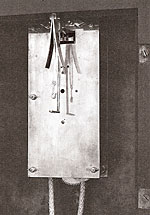
Fig. 8 (click to enlarge)
The back plate of clock by Isaac Thuret, Museum
Boerhaave,
Leiden,
inv.no.Vg854.
●
Thirty years ago Jean-Claude Sabrier was asked while visiting a French
Chateau, to examine a clock kept in a cardboard box in the attic.
He informed the owners of the great importance of this clock and
persuaded them not to restore it. A few months ago, in preparation for
this article, he persuaded the current owners to release the clock for
thorough examination and restoration and full details of it follow in
Figs 9-23.
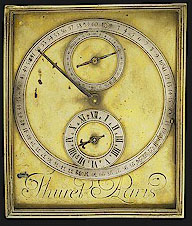
Fig. 9 (click to enlarge)
The Thuret clock discovered by Jean-Claude Sabrier, the case with
opening door.
(view high res
picture)
●
The case is made of brass with hinged and glazed front door and sliding
back panel. It is attached to the dial by four screws inserted in
right-angle brackets attached to the back of the dial. The case is hung
on the wall by rings at the side and not on the top. Large pyramidal
headed screws adjust the distance from the wall. The dimensions are: 175
x 132 x
108 mm.
●
The dial is gilded brass with silvered chapter rings and original steel
hands. The chapter rings are now screwed to the dial plate. The
signature has two small unused holes at either end
suggesting a covering plaque. The dimensions are: 235 x
192 mm.
●
The movement has exactly the same train as in Huygens’ diagram (see Fig.
2). The train count corresponds to a 1 second pendulum.
| Train |
|
| 80 |
First wheel |
|
8 |
48 |
Intermediate wheel |
| |
8 |
48 |
Contrate wheel |
|
|
24 |
15 |
Escape wheel |
|
|
Pendulum |
|
Beats 60 p/m
Nominal length 1 m.
(1 sec.)
|

Fig. 10 (click to enlarge)
Original hands.
(view high res.
picture)

Fig. 11 (click to enlarge)
of the metal box case and dial.
(view high res.
picture)
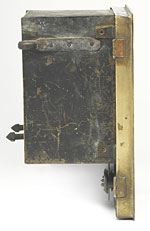
Fig. 12 (click to enlarge)
Thuret clock, side view, metal box case,
hanging loops riveted to case
sides.
(view
high res. picture)

Fig. 13 (click to enlarge)
Thuret clock, back view, box case removed.
(view high res.
picture)
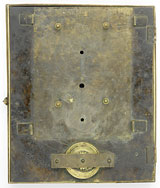
Fig. 14 (click to enlarge)
Thuret clock, back of dial, case and movement removed.
(view high res.
picture)
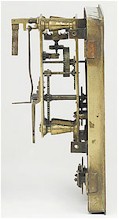
Fig. 15 (click to enlarge)
View of movement, note the crown wheel and large diameter pinion. Also
note the hole in the first arbor originally used for the pin securing
the driving pulley
(now missing)
(view high res.
picture)
●
The dimensions of the movement plates are:
back 148.5 x
77 mm, front 167.5 x
77 mm. The first-wheel arbor was originally fitted
with a driving pulley. Assuming the dimensions of the movement plates in
the drawing of Fig. 2 are the same as this clock then one can determine
that the diameter of the pulley was about
25 mm.
This diameter would give a drop of
188 cm
per 24 hours. The height of the clock centre for 30 hours would be at
least
235 cm or
7 ft
10 in.

Fig. 16 (click to enlarge)
The outer sides of the back (left) and front (right) movement plates.
(view high res.
picture)
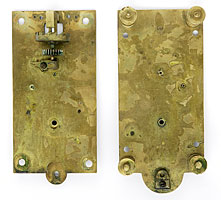
Fig. 17 (click to enlarge)
The inner sides of the back (left)
and front (right) movement plates.
(view high res.
picture)

Fig. 18 (click to enlarge)
Thuret clock. The wheels and pinions.
(view high res.
picture)
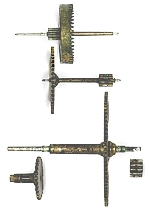
Fig. 19
(view high res.
picture
●
To increase the duration between windings and allow for a lower
positioning on the wall this pulley has subsequently been removed and
the first wheel arbor extended through the back plate for an additional
pinion. This pinion was driven by an extra wheel (now missing) situated
between the bracket and the backplane, its arbor pivoted at the front in
a small cock secured to the inside of the front plate. The arbor of this
extra wheel carried the new, and probably larger, driving pulley. The
lower position of this pulley was only accommodated by filing flats on
the insides of the two lower pillars. The ratchet
pulley mounted on the back of the dial may still be the original, but
reversed.
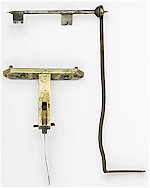
Fig. 20 (click to enlarge)
The back-cock would have originally held a silk suspension (two threads)
and the cycloidal cheeks.
(view high res.
picture)
There is a section of partly threaded square brass rod which was found
with the clock and has been recorded in case it was part of the original
pendulum. It is too large to pass through the pendulum crutch however it
may have been part of a lower section of the pendulum. The pulleys,
weights and pendulum
are missing.
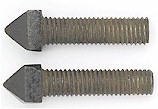
Fig. 21 (click to enlarge)
Pyramidal headed screws for adjusting
the vertical position of the clock
on the wall.
(view high res.
picture)
|
TPI25 |
fig. |
Screw thread. |
| 48 |
|
Wheel
bracket.
|
| 32 |
|
Bottom
potence. |
| 32 |
22 |
Back
cock. |
| 32 |
|
Minute
bridge. |
| 32 |
23 |
Case.
(brass) |
| 20,5 |
21 |
Case
back plate. |
| 23 |
|
Pendulum
rod. (brass) |
Table 2
screw thread details.
Traditional Inch/Pouce = 27.07 mm.

Fig. 22 (click to enlarge)
Back-cock screws.
(view high res.
picture)

Fig. 23 (click to enlarge)
Case
securing screws.
(view high res.
picture)
●
The two screw holes in the dial plate either side of the signature are
interesting. The only explanation for these holes is that they once held
a plate covering the signature. The hiding of Thuret’s name would very
much resonate with Huygens’ secretive behaviour. It is quite possible
therefore that both clocks belonged to Huygens and there is no reason to
believe that they are not of the same date as the 1657 woodcut.
●
With regard to their description in previous articles as astronomical
regulators it is important to remember that any experimental clock of
this period that was designed to be tested accurately would be regulated
with reference to astronomical observation and therefore likely to have
regulator dials.

ISAAC THURET
Isaac Thuret was born into a Protestant family at Senlis in
France,
around 1630. He acquired impressive social connections. His sister
Susanne married Charles Francois de Sylvestre, Maître de dessin des
Enfants de France and his son Jacques married the daughter of the famous
designer to the court of Louis XIV, Jean Bérain.(26
A 25 year- old Thuret, rapidly becoming
France’s
greatest seventeenth century clockmaker, would have been a natural
contact for his contemporary Huygens, when the latter visited
Paris
in 1655. Huygens spent 4 to 5 months in
France
in the autumn of that year, mainly in
Paris.
There is no mention of Thuret’s name in Huygens’ correspondence
published in the Oeuvres Completes until 1662 when the latter is
informed that his father was impressed by Thuret’s clocks and asks his
brother Lodewijk, in a letter of April l2 ‘how are these Thuret clocks
made, for which my father pays 10 or 12 pistoles and prefers to his own?
If we could know the form it could be used to instruct the clockmakers
here...'.(27 This reference has been taken as indicating Huygens’ lack of
acquaintance with Thuret, sometimes giving the impression that it is a
general enquiry about Thuret’s work. However the complete passage
clearly shows that it is an enquiry about a specific type of clock with
which Huygens’ compatriots, under his patronage, were in direct
competition. Huygens is responding here to a previous comment and taking
advantage of his brother’s location in
Paris.
Given also Huygens’ conflict of interest, the request in this letter is
not surprising and does not preclude previous close cooperation between
Thuret and himself.
●
The next reference to Thuret, again in family correspondence, occurs
several times in 1664 and concerns the sending of clocks made by Claude
Pascal to Thuret for repair.
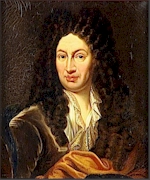
Jean Chapelain
(1595-1674)
In 1665, Jean Chapelain writes to Huygens
on the subject of the latter’s remontoire clock for which a French
patent was granted, ‘that excellent clockmaker Monsieur Thuret, of whom
you yourself have told me much good, visited me yesterday and asked me
to offer you his services for the construction of clocks to be used on
ships and for their sale and distribution.. ‘.(28
Chapelaine was authorised
to dispose of the patent on the inventor’s behalf and it was probably
that fact, or the chance that a random visit presented, that caused
Thuret to make this indirect approach. Huygens agreed to this request 2
weeks later.
●
In 1666 Huygens moved to
Paris
and presumably continued to employ Thuret. However the next episode
involving the two that appears in Oeuvres Completes is their
collaboration and subsequent contention over the balance spring which
took place in 1675 and is outside the scope of this article

CONCLUSION
The clock illustrated in Horologium Oscillatorium has up to now
been attributed without dispute to Isaac Thuret(29
albeit without realising its early date. There is no need to withdraw
this attribution. To the contrary, Huygens had ample opportunity to meet
Thuret in
Paris
in the autumn of 1655. Huygens himself is linked to one of the surviving
Thuret clocks and both examples described here, certainly look as early,
if not earlier than the Coster clocks. For the sake of completeness it
may be asked whether Thuret clocks could be later copied from this
illustration rather than visa-versa. However, the clock in the
illustration, like Huygens’ research in early 1657 reveal the work of a
clockmaker, and the search for someone else would be at the expense of
plausibility. It is probable that Thuret did not initially have
permission to make these clocks for anyone other then Huygens and by
the time that restriction had ceased, clock design had progressed beyond
the need to reproduce the original model.
●
The remaining problem concerns the fact that the first mention of
Thuret’s name in the Oeuvres Completes is 7 years after Huygens’ first
visit to
Paris.
The likelihood is that Huygens went to great lengths to keep Thuret and
his contribution secret. However, it is also very important here to
recognise the limits of the Oeuvres Completes in general and Huygens’
surviving correspondence in particular. This is a classic example of
where absence of evidence is not, of itself, evidence of absence. As is
so often the case, it is not known how Huygens compiled or subsequently
edited his own correspondence. It is far from complete. Where is the
trade correspondence? Did he later remove contentious or awkward
material with a view to posterity?
●
Apart from his alleged secrecy there is an aspect of Huygens’ character
which is relevant to the changing dynamic of his relationship both with
his invention and with Thuret; and that is the rapidity with which he
progressed through successive projects.
●
This progression should be viewed against the backdrop of his
many simultaneous scientific enquiries. Naturally his first horological
priority was to eliminate variation and this meant, among other things,
that he had to start with weight drive. By early 1657, while preparing
to franchise various imprecise domestic models, he was working, almost
certainly in secrecy, on a maritime pendulum clock with spring drive as
mentioned in the Mylon letter quoted previously. Huygens was clearly
confident of overcoming the problems of pendulums at sea. For ships’
chronometers he favoured a going barrel without fusee. Although he
vaunted the resistance of his isochronal pendulum against the variations
of power in a going barrel, the main reason for rejecting the fusee was
its lack of maintaining power during winding. However, he found that his
isochronal cheeks, fine when stable in a wall clock, changed the
pendulum length when even slightly tilted. This led him, in late 1657 or
early in 1658 to develop his half-second clock with ‘O-P’ gearing. This
gearing avoided the need for isochronal cheeks
by lessening the amplitude of the pendulum to that arc where the
circular and the tautochrone hardly diverge. This second clock was
therefore presumably intended to be developed into a marine clock
although the possibility of an increase in pendulum amplitude caused by
pitch or roll must have been a concern. Again Huygens commenced by
testing a weight driven version and he presumably found that the
performance was insufficient for further development in marine use. At
this point he probably realised that longitude horology required a
radically new approach.
●
In November 1659, Huygens developed a conical pendulum clock
( ) which he
used to obtain a new value for the constant of gravitational
acceleration. It is not known who constructed any of these subsequent
clocks. It is established that his conical pendulum clock existed, for
he obtained his new value for free fall, ‘ex motu conico penduli’
(30
The
lack of any mention of it in the correspondence of the Oeuvres Completes
and the editorial speculation that it did not exist, provides a further
caveat to regarding such an archive as an audit of events. With his
extraordinarily busy life and changing agenda, it is quite possible that
Huygens temporarily abandoned his far-off Parisian clockmaker in the
first years of the 1660s, if not before. The lack of mention of Thuret
in Huygens’ papers is no doubt chiefly due to the fact that Huygens saw
no share for the constructor in the celebrity of his invention. At least
two Thuret clocks have thus been deprived for 350 years of their proper
recognition. They are the sisters of his first pendulum clock and the
earliest surviving models of the first complete pendulum theory. And as
such they embody what may be, despite modern perspective, the defining
achievement of a prolific immortal of the Scientific Revolution. ) which he
used to obtain a new value for the constant of gravitational
acceleration. It is not known who constructed any of these subsequent
clocks. It is established that his conical pendulum clock existed, for
he obtained his new value for free fall, ‘ex motu conico penduli’
(30
The
lack of any mention of it in the correspondence of the Oeuvres Completes
and the editorial speculation that it did not exist, provides a further
caveat to regarding such an archive as an audit of events. With his
extraordinarily busy life and changing agenda, it is quite possible that
Huygens temporarily abandoned his far-off Parisian clockmaker in the
first years of the 1660s, if not before. The lack of mention of Thuret
in Huygens’ papers is no doubt chiefly due to the fact that Huygens saw
no share for the constructor in the celebrity of his invention. At least
two Thuret clocks have thus been deprived for 350 years of their proper
recognition. They are the sisters of his first pendulum clock and the
earliest surviving models of the first complete pendulum theory. And as
such they embody what may be, despite modern perspective, the defining
achievement of a prolific immortal of the Scientific Revolution.

ACKNOWLEDGEMENTS
I wish to express my gratitude to Jean-Claude Sabrier for
discovering and making available a hitherto unpublished Thuret clock.
And to Andrew Crisford who provided from his libraries the conclusive
evidence of Benjamin Martin.
March
2009, Copyright:

LINKS
Chr.
Huygens Horologium 1658.
(pdf)
The
Antiquarian Horological Society.
(This article is subject to ongoing
revisions.) |




























